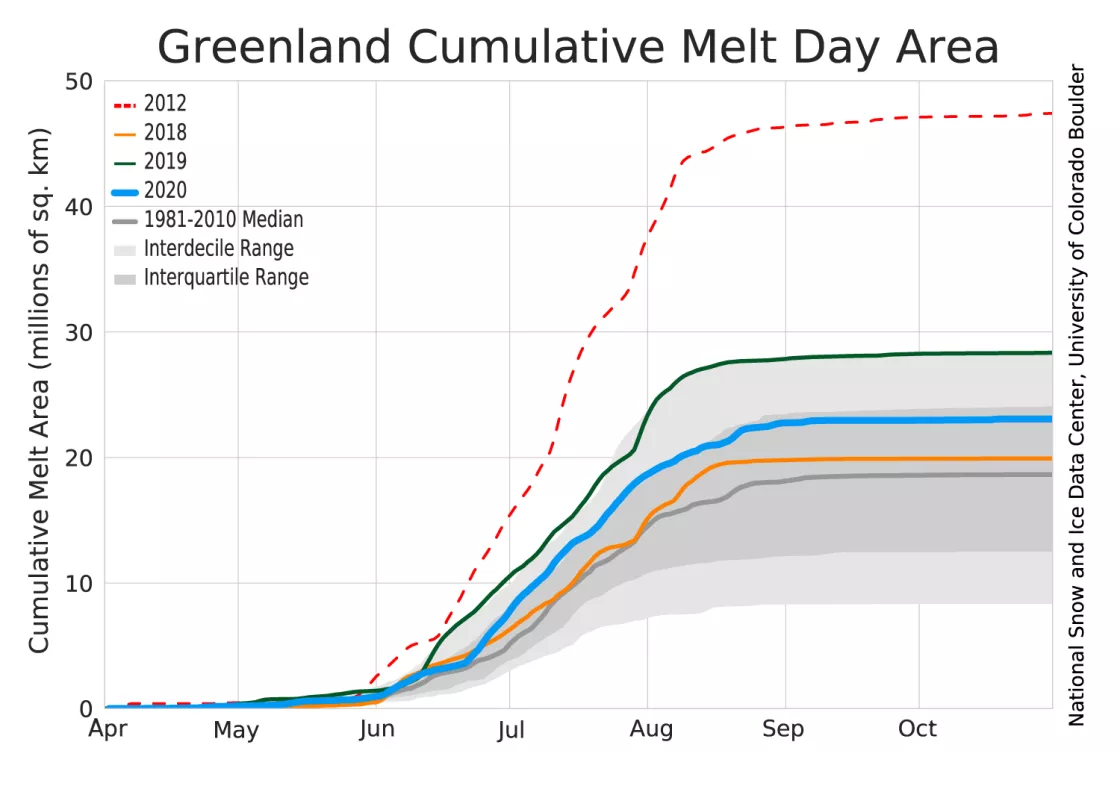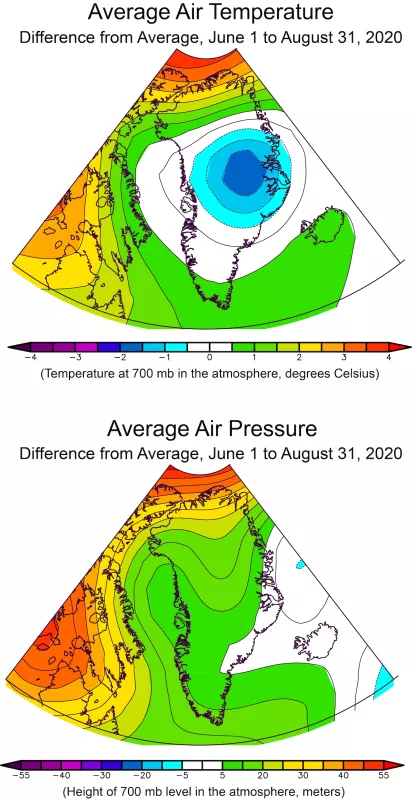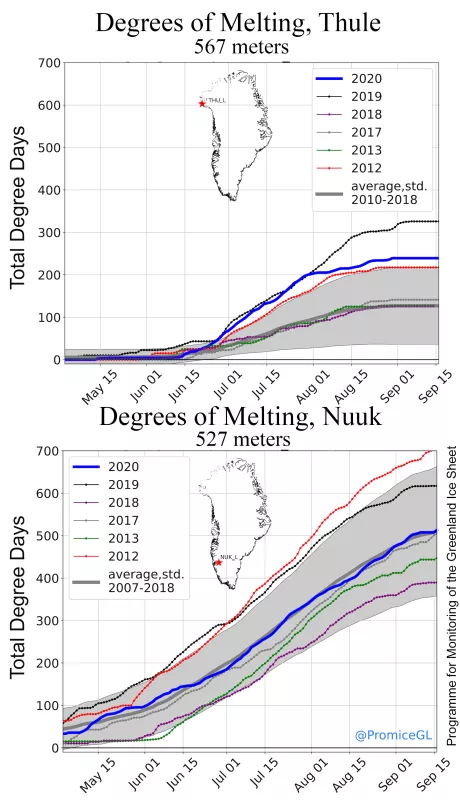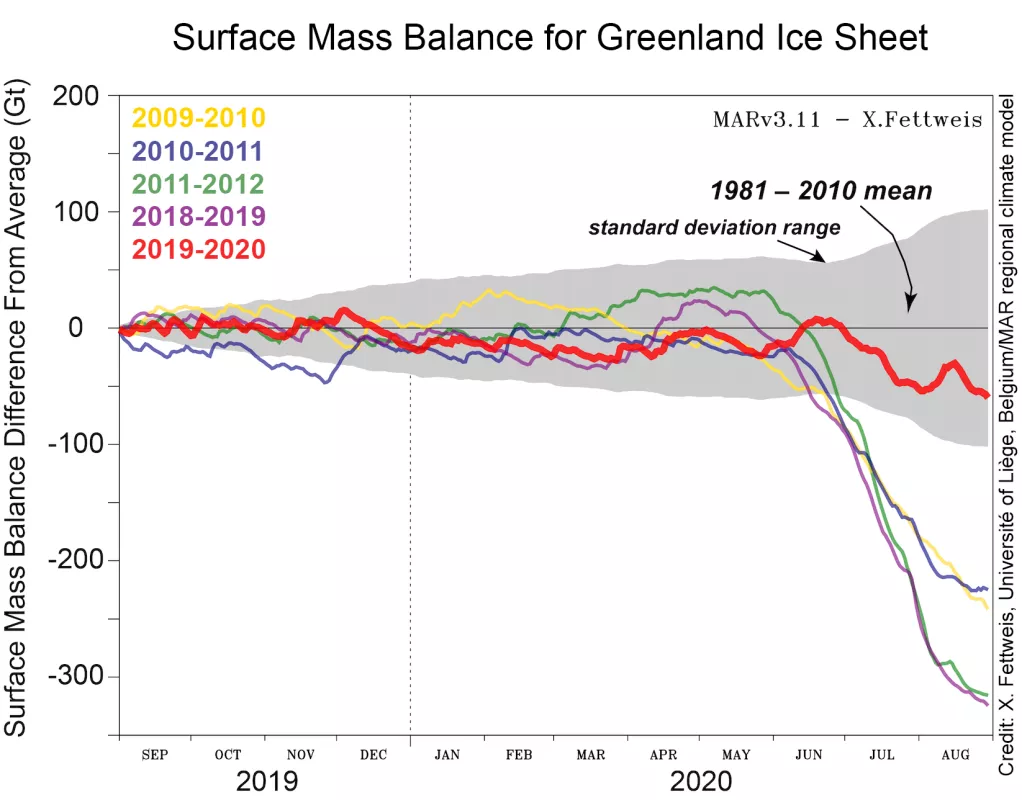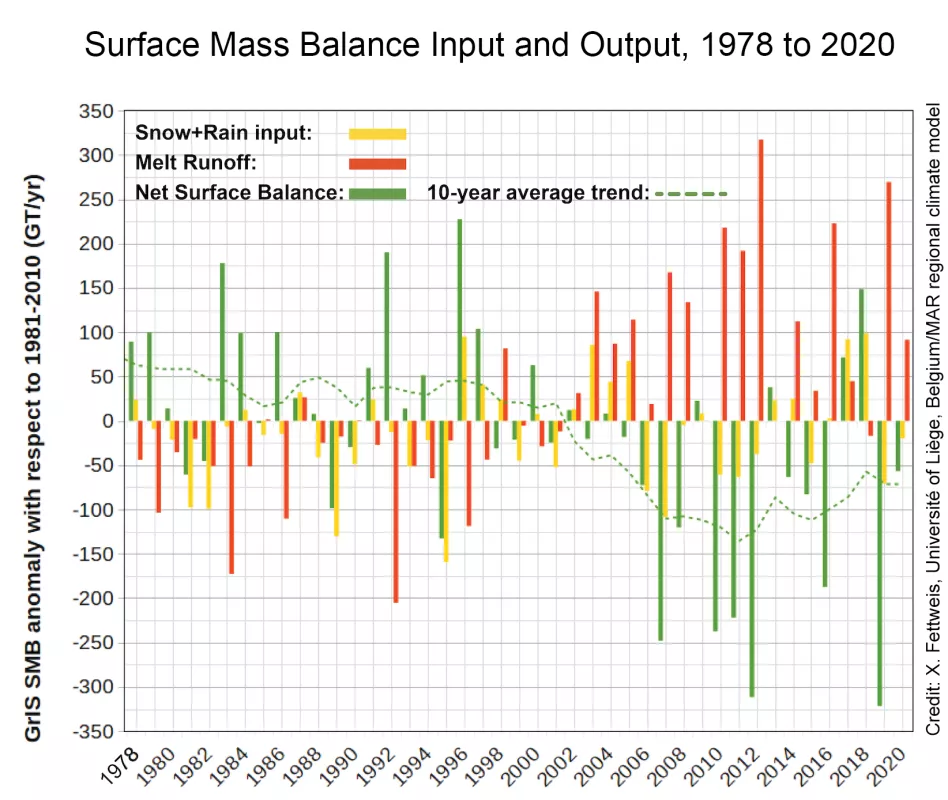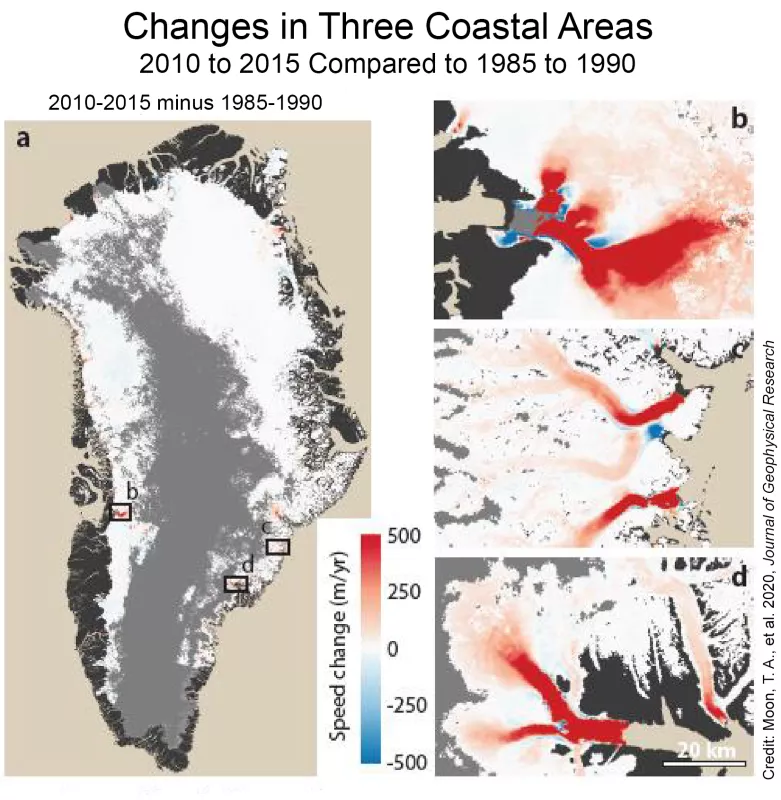The 2020 melt season in Greenland is over, finishing thirteenth for cumulative melt-day extent in the 42-year satellite record. Melt extent was greater than any year prior to 2002, with about 70 percent of the ice sheet experiencing some melting. Melting was moderately intense in the northeastern region but less so in the southwest, where in recent high-melt years the ice sheet has been losing mass and exposing bare ice. Much of the upper elevation areas of the ice sheet saw no melting this year. The balance between snow and rain input and melt runoff indicates a small net loss of ice this year. This does not include the imbalance caused by ice flow.
Overview of conditions
The total aerial extent of surface melting (total melt-day extent) through October 31 is slightly above the 1981 to 2010 average at 23.10 million square kilometers (8.92 million square miles) for 2020 versus 22.00 million square kilometers (8.49 million square miles) for the 1981 to 2010 average. Melting was intense in the northeastern section of the ice sheet, with 20 to 25 additional melt days than average, and moderately intense in the southwestern section of the ice sheet with 10 to 20 additional melt days (Figure 1). The peak melt day for 2020 was on July 10, when 551,000 square kilometers (213,000 square miles), or 34 percent of the ice sheet surface, melted. There were two later melt events of note, on August 20 when extensive areas in northwestern Greenland melted totaling just over 20 percent of the ice sheet, and a late event on October 17, limited to the southwestern ice sheet totaling under 3 percent of the ice. Overall the pace of melt during the 2020 season was close to average until late June when a moderately prolonged period of above-average melt added to the cumulative total, bringing it to the upper part of the interquartile range (Figure 2). Thus, the 2020 total melt extent tracked at a level larger than about 75 percent of past years in the satellite record after late June.
Conditions in context
Air temperatures above Greenland were generally near average over the summer months this year (Figure 3). Higher-than-average temperatures, with up to 3 degrees Celsius (5 degrees Fahrenheit) were limited to the far northern flank of the ice sheet, and significantly lower-than-average temperatures of 1.5 to 2 degrees Celsius (3 to 4 degrees Fahrenheit) near the Scoresby Sund in east-central Greenland. Though local surface winds can be quite high under certain conditions, air pressure patterns over the ice sheet indicated generally light regional winds that favored a westward to southwestward flow. Air off the far northern Atlantic Ocean in the Norwegian Sea swept in across the ice sheet. This pattern of temperature and pressure was remarkably consistent through all the individual months of June, July, and August. A look at weather station data along Greenland’s west coast reflects the regional temperature trends (Figure 4). Nuuk, the capital of Greenland on the central southwestern coast, had summer temperatures very close to average for that region. Thule, near a large US military base in northwestern Greenland, had a much warmer than average summer, but was still cooler than Nuuk, which is nearly 1,500 kilometers (580 miles) to its south.
Greenland still on a diet
Net surface mass balance (SMB), which is the snow and rain input minus evaporation and melt runoff, was only slightly less than average at 314 billion tons, or 56 billion tons below the 1981 to 2010 average, according to the MARv3.11 climate model (Figure 5a). This can be compared to the major melt and ice loss years of 2012, 2019, and others in the last decade with values between 225 and 325 billion tons below average (Figure 5b). The 2020 regional pattern had low SMB all along the western side of the ice sheet but near average to slightly above average along most of the eastern coastal areas.
Greenland's glaciers: more to their change than just faster flow
With a growing record of satellite imagery and advances in image processing, scientists are now able to better explore the changes to Greenland's coastal area in the last three decades. A new paper by our colleagues Twila Moon, Alex Gardner, Bea Csatho, Ivan Parmuzin, and Mark Fahnestock analyzes how ice outflow speed and surface melting have increased. Every year since 1998, the ice sheet has overall lost ice. Satellite sensor improvements, such as on Landsat 7 and 8, and improvements in image processing for ice flow mapping (see ITS_LIVE) have created an improved set of maps for documenting changes in Greenland’s ice outflow. These maps reveal substantial reconfigurations of several major glaciers (Figure 6). For many fast-flowing glaciers, the research team found that the central channel of fast flow has sped up, but the edges of the channel have slowed, effectively narrowing the width of the fast flow area. Researchers also see evidence for ice flow rerouting and even abandonment of some glacier outlets. While thinning ice and retreats from the ice edge change the ice sheet, the shape of the land beneath the ice remains mostly unchanged. In some areas the ice cannot flow over the landscape via the historical pathways. This reconfiguration of the ice sheet has important implications for other elements of the Greenland system, such as the flow of water beneath the ice sheet, and the movement of sediment and nutrients into the fjords. The new data collected by ITS_LIVE are allowing researchers to characterize and understand what rapid deglaciation looks like on scales that matter for wildlife, fisheries, infrastructure, and communities.
Further reading
Moon, T. A., A. S. Gardner, B. Csatho, I. Parmuzin, and M. A. Fahnestock. 2020. Rapid reconfiguration of the Greenland Ice Sheet coastal margin. Journal of Geophysical Research: Earth Surface, 125, doi:10.1029/2020JF005585.
Tedesco, M. and X. Fettweis. 2020. Unprecedented atmospheric conditions (1948–2019) drive the 2019 exceptional melting season over the Greenland ice sheet. The Cryosphere, 14, 1209–1223, doi:10.5194/tc-14-1209-2020.
The 2020 Greenland Ice Sheet SMB simulated by MARv3.5.2 in real time
Polar Portal's Greenland surface conditions
Programme for Monitoring of the Greenland Ice Sheet (PROMICE)
Acknowledgements
Jason Box, Geological Survey of Denmark and Greenland (GEUS) in Copenhagen, Denmark Xavier Fettweis, Université of Liège in Belgium, providing the MARv3.11 model results Twila Moon, National Snow and Ice Data Center Thomas Mote, University of Georgia

